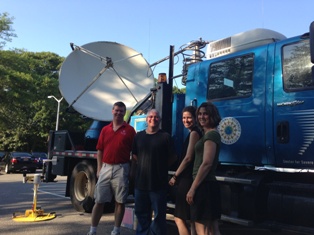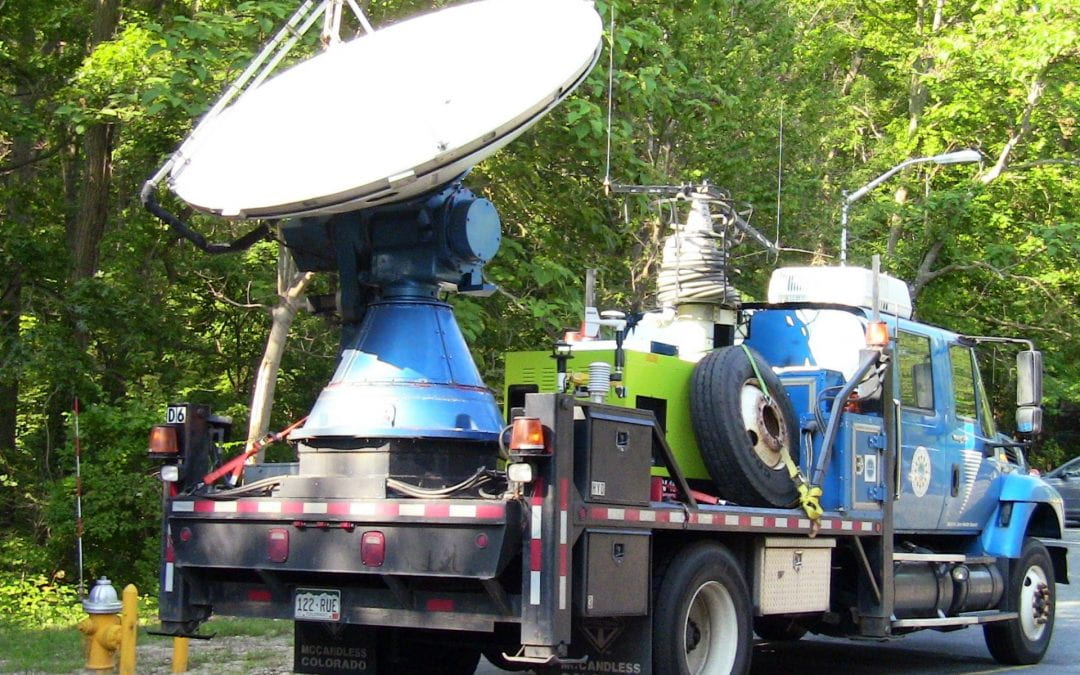Mission #6: The MCV That Took Too Long!
The DREAMS Project mission for Thursday, June 27th was contingent upon hoping that convection developed out ahead of a larger-scale thunderstorm system called a mesoscale convective vortex or MCV. The actual MCV was forecast to move across Long Island close to...Mission #5: Scattered Convection From the North Shore
The DREAMS Project had a down day on Tuesday, June 25 after the exciting mission of the previous day. During the afternoon, Dr. Colle held a weather briefing that connected students and the National Weather Service’s Science Operations Officer Jeffrey Tongue to...Mission #4: Scattered Convection Near NYC
The DREAMS Project started its second week with a mission, to keep the DOW busy of course! The forecast for Monday, June 24 called for a slight chance of scattered severe thunderstorms in the New York City vicinity and an enhancement of the New York Bight Jet....
Stony Brook University Hosts NSF Funded Storm Chasing Project
Photo above: Pictured in front of the Doppler on Wheels 6 from left to right are: Professor Brian Colle, SoMAS at Stony Brook University; Joshua Wurman and Karen Kosiba of the Center for Severe Weather Research; and Kelly Lombardo, SBU Postdoctoral researcher....
Stony Brook University Hosts NSF Funded Storm Chasing Project
STONY BROOK, NY, June 26, 2013 – Stony Brook University in collaboration with the National Weather Service (NWS) and the Center for Severe Weather Research in Boulder, CO, is hosting and participating in the DREAMS (Doppler Radar for Education And Mesoscale Studies)...Missions #2 & #3: The Quiet Version of the Long Island Sea Breeze
A sea breeze occurs when the solar radiation from the sun heats up the land a lot more than a nearby body of water due to water’s high heat capacity, or resistance to absorbing heat quickly. The air near the ground heats up, becomes less dense and thus rises....Mission #1: Embedded Convection Within Stratiform Precipitation
The first day out in the field with the Doppler on Wheels (DOW) was a wet one for the students and faculty involved. Tuesday, June 18th was Mission #1 and the second day of the field campaign. The forecast was for precipitation to form somewhere along a frontal...The Basics of Doppler Radar
The Doppler on Wheels (DOW) is spending some time on Long Island to do what our local National Weather Service radar can’t– if the weather won’t come to the radar, then the radar can go to the weather! Radar is most commonly known since the...The DREAMS Project
This summer is a special one for Dr. Brian Colle’s Coastal Meteorology and Atmospheric Prediction (COMAP) Group because Stony Brook University is home to an exciting field campaign, the Doppler Radar for Education and Mesoscale Studies (DREAMS) Project. A team...
SoMAS Scientists Find That Fukushima-Derived Radioactivity in Seafood Poses Minimal Health Risk
In 2012, SoMAS Professor Nicholas Fisher and postdoctoral scholar Zosia Baumann, working with a colleague at Stanford University’s Hopkins Marine Station, reported that they had detected radioactivity in Pacific bluefin tuna swimming off the California coast. The...
SBU Study Published in PLoS ONE Shows Rate of Temperature Change Along World’s Coastlines has Itself Changed Dramatically Over the Past Three Decades
Photo above: Route 1, Monterrey Coastline; credit Dr. Hannes Baumann STONY BROOK, N.Y., June 28, 2013 – Locally, changes in coastal ocean temperatures may be much more extreme than global averages imply. New research published in the June 18 edition of Public...
Bermuda Rise (BaRFlux)
Principal Investigators: David Black, Cindy Lee, Rob Armstrong and Kirk Cochran Funded by NSF Ocean Sciences Division Students Supported: TBA Project Description:The goal of this work is to achieve a better mechanistic understanding of the ocean’s role in the global...



